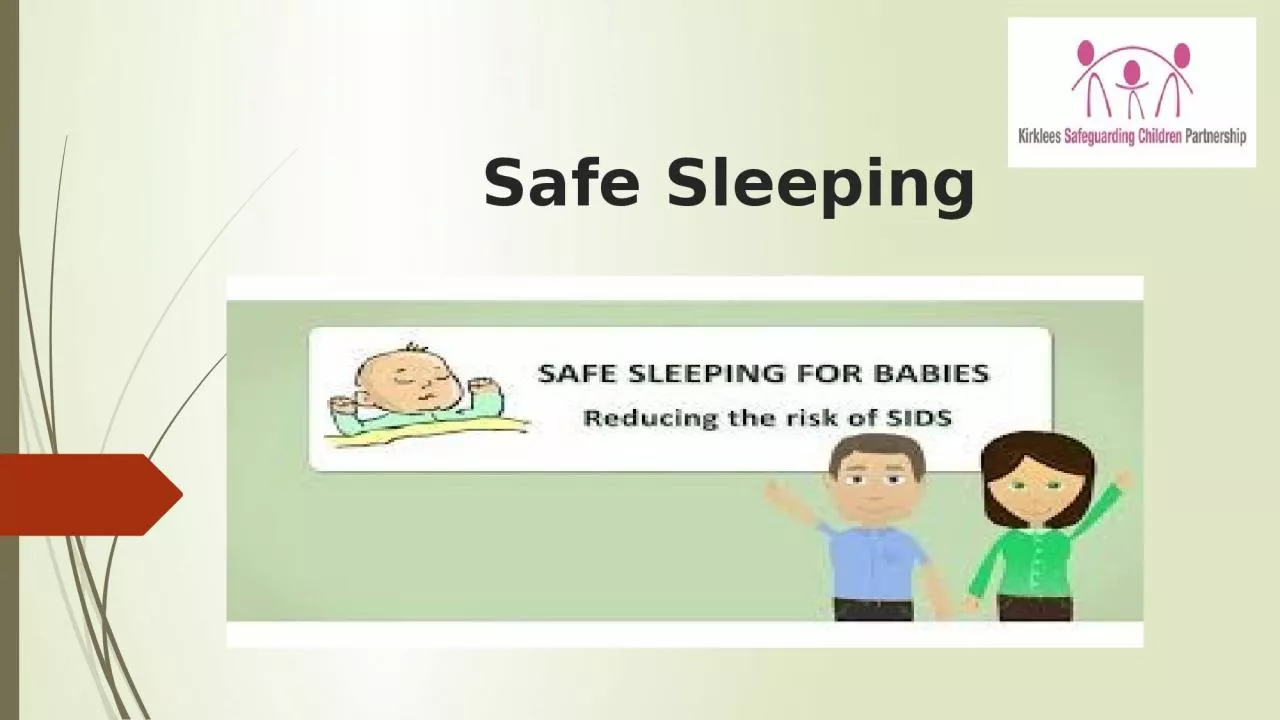

ep Place your baby on their back to sleep from the very beginning for both day and night sleeps This will reduce the risk of cot death Its not as safe for babies to sleep on their side or tummy as on their back Healthy babies placed on their backs arent more likely to choke ID: 919295
Download Presentation The PPT/PDF document "Safe Sleeping Place your baby on their b..." is the property of its rightful owner. Permission is granted to download and print the materials on this web site for personal, non-commercial use only, and to display it on your personal computer provided you do not modify the materials and that you retain all copyright notices contained in the materials. By downloading content from our website, you accept the terms of this agreement.
Slide1
Safe Sleeping
Slide2Place your baby on their back to sleep
Place your baby on their back to sleep from the very beginning for both day and night sleeps. This will reduce the risk of cot death.
It's not as safe for babies to sleep on their side or tummy as on their back. Healthy babies placed on their backs aren't more likely to choke.
Once your baby's old enough to roll over, there's no need to worry if they turn onto their tummy or side while sleeping.
Slide3The Risks of Co-Sleeping
The safest place for your baby to sleep for the first 6 months is in a cot in the same room as you.
It's especially important not to share a bed with your baby if you or your partner:
are smokers (no matter where or when you smoke and even if you never smoke in bed)
have recently drunk alcohol
have taken medication or drugs that make you sleep more heavily
The risks of co-sleeping are also increased if your baby:
was premature (born before 37 weeks), or
had a low birth weight (less than 2.5kg or 5.5lb)
As well as a higher risk of SIDS, there's also a risk you might roll over in your sleep and suffocate your baby.
Or your baby could get caught between the wall and the bed, or roll out of an adult bed and be injured.
Slide4Never sleep with a baby on a sofa or armchair
It's lovely to have your baby with you for a cuddle or a feed, but sleeping with your baby on a sofa or armchair is linked to a higher risk of SIDS.
It's safest to put your baby back in their cot before you go to sleep.
Slide5Don't let anyone smoke in the same room as your baby
Babies exposed to cigarette smoke before and after birth are at an increased risk of SIDS. Don't let anyone smoke in the house, including visitors.
Ask anyone who needs to smoke to go outside. Don't take your baby into smoky places.
If you're a smoker, sharing a bed with your baby increases the risk of cot death.
Slide6Don't let your baby get too hot or too cold
Overheating can increase the risk of SIDS. Babies can overheat because of too much bedding or clothing, or because the room's too hot.
When you check your baby, make sure they're not too hot. If your baby's sweating or their tummy feels hot to the touch, take off some of the bedding. Don't worry if their hands or feet feel cool – this is normal.
It's easier to adjust for the temperature by using layers of lightweight blankets. Remember, a folded blanket counts as 2 blankets. Lightweight, well-fitting baby sleeping bags are a good choice, too.
Babies don't need hot rooms. All-night heating is rarely necessary. Keep the room at a temperature that's comfortable for you at night – about 18C (65F) is ideal.
Slide7If it's very warm, your baby may not need any bedclothes other than a sheet.
Even in winter, most babies who are unwell or feverish don't need extra clothes.Babies should never sleep with a hot water bottle or electric blanket, next to a radiator, heater or fire, or in direct sunshine.Babies lose excess heat through their heads, so make sure their heads can't be covered by bedclothes while they're asleep.Remove hats and extra clothing as soon as you come indoors or enter a warm car, bus or train, even if it means waking your baby.
Slide8Don't let your baby's head become covered
Babies whose heads are covered with bedding are at an increased risk of SIDS.
To prevent your baby wriggling down under the covers, place them in the "feet to foot” position. This means their feet are at the end of the crib, cot or Moses basket.
Tuck the covers in securely under your baby's arms so they can't slip over their head. Use 1 or more layers of lightweight blankets.
Use a baby mattress that's firm, flat, well-fitting, clean and waterproof on the outside. Cover the mattress with a single sheet.
Don't use duvets, quilts, baby nests, wedges, bedding rolls or pillows.t" position. This means their feet are at the end of the crib, cot or Moses basket.
Slide9Feeding, dummies and SIDS
Breastfeeding your baby reduces the risk of SIDS.
It's possible using a dummy at the start of a sleep also reduces the risk of SIDS. But the evidence isn't strong and not all experts agree that dummies should be promoted.
If you do use a dummy, don't start until breastfeeding is well established. This is usually when they're around 1 month old.
Stop giving them the dummy when they're between 6 and 12 months old.
Slide10Additional Resources for Professionals
SIDS and Co-sleeping:https://www.lullabytrust.org.uk/safer-sleep-advice/
https://www.unicef.org.uk/babyfriendly/baby-friendly-resources/sleep-and-night-time-resources/co-sleeping-and-sids/
westyorkscb.proceduresonline.com
Slide11Other sources of useful information for parents
https://liftthebaby.org.uk/
(
OxfordshireCCG
)#Everysleepcounts - https://youtu.be/guvqM4kBUDY
(
Hampshirescp
)
https://thedadpad.co.uk/
https://www.lullabytrust.org.uk/safer-sleep-advice/